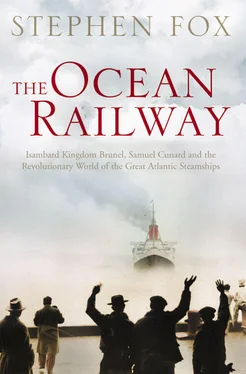One possible solution to these fuel and boiler limitations was to reduce the route across the ocean. The shortest great circle course between Europe and North America ran just 1900 miles between Valentia, at the southwestern tip of Ireland, to St John’s, Newfoundland. The run from there to Halifax brought the total to 2400 miles. In 1824 a group in London under Maurice Fitzgerald, the knight of Kerry – an Irish statesman and member of Parliament – launched the Atlantic Steam Navigation Company to carry traffic from London to Valentia to Halifax to New York. The company included Alexander Nimmo, a government civil engineer who was building piers and harbours along the Irish coast, and other men of influence. They planned steamships of 1000 tons, almost twice the size of any vessel then afloat. In the autumn of 1825, American newspapers declared it ‘ almost certain’ that the service would start in the following spring. But it never did. In these years, just before the railway, the journey by coach and steamboat from London to Valentia took fifty hours, and forty hours from Liverpool. The whole trip would have demanded at least four changes of conveyance, with the usual uncertainties of baggage and schedules, to reach New York. It was much easier just to take one of the swift sailing packet lines the whole way from London or Liverpool. The Valentia company disappeared, though the general idea was periodically revived.
Junius Smith’sprotracted crusade for an Atlantic steamship line began with an interminable fifty-four-day sailing voyage from England to New York in the autumn of 1832. He was then fifty-two years old, a Connecticut Yankee and Yale graduate who had lived in London since 1805, prospering as a merchant. Dawdling across the Atlantic for almost two months, Smith had plenty of time to ponder an alternative means of ocean travel. In his innocence of steamship technology, he conceived a line of four steaming packets, to cost £30,000 each and make the hard westbound run from Portsmouth to New York in just twelve or thirteen days. ‘ I shall notrelinquish this project,’ he vowed, ‘unless I find it absolutely impracticable.’ For two years, nobody he contacted in London or New York expressed any flicker of interest. Smith kept trying, virtually alone. ‘ The patienceand labor of forming a company in London is beyond all that you can imagine,’ he wrote to an associate in New York. ‘It is the worst place in the whole world to bring out a new thing, the best when it is done… All the old sailing interest of course is against me.’
The project became credible when Smith extended his search for supporters to northern England. Macgregor Laird, from a Scottish shipbuilding family that had moved down to Liverpool, became the secretary of Smith’s projected company. He brought acutely needed technical expertise and steamship contacts to the enterprise. They planned four ships of 1200 tons and 300 horsepower, to make the trip from London (and now Liverpool as well) to New York in fifteen days on average. After The Times announcedthe scheme in November 1835, over £1 million in stock was subscribed – though not actually paid up – in a few weeks. Many English investors, scenting any reasonable plan, were ready for transatlantic steam. ‘ Job’s patienceis much celebrated,’ Smith remarked, ‘but I don’t think that he ever undertook…to establish a steam company.’
Meantime brunel and his Bristol associates were getting ready to build their own Atlantic steamship, the Great Western, starting out a few months behind Smith and Laird. brunel decided on the size of the engine and picked its builder. He went through the motions of a careful search, taking tenders from three firms. But given his family’s intimate ties to Maudslay over four decades, the five years that Thomas Guppy had spent there as a young engineer, the company’s long experience in making powerful marine engines, and Joshua Field’s eminence as an engineer, the contract could have gone nowhere else. The Maudslay firm agreed to build a two-cylinder side-lever engine of 400 horsepower. For this special project, with its high and public stakes, Field designed a system of engine cams that improved steam economy – useful for the broad Atlantic – and invented new, more efficient double-storey boilers. brunel occasionally dropped by the Maudslay works at Lambeth, checking on the engine’s progress, and he mediated squabbles between Claxton and the firm’s management about bills and payments. ‘ There are but fewgood Engine builders,’ he reminded Claxton, ‘and it will not be prudent to quarrel with the principal one.’
brunel’s role in the ship herself has been exaggerated. He came to the project with no shipbuilding experience and throughout its construction was intensely preoccupied with the Great Western Railway. Claxton and Patterson, the real ship men, had already recommended a very large vessel, and Patterson designed the hull and fittings with just occasional advice from the others. brunel, drawing on his knowledge of bridge stresses and bracings, did recommend adding to the ship’s longitudinal strength with extra iron bolts and trusses. (A longer ship, so the logic went, would need additional strength when suspended from the bow and stern between two high ocean waves.) brunel wanted to make the ship 400 to 500 tons larger, but Patterson doubted her stability at that size, so she was kept to 1320 tons. brunel and Guppy, his fellow landlubber, urged fitting larger cabin windows at the stern for more light and air, as in drawing-room windows ashore. Claxton ‘ took the libertyof reminding them’, he recalled, ‘that there was water outside which was sometimes very uneven in its surface, and unlike the generality of lawns; and strange as it may appear, Mr. Patterson, their builder, agreed.’ brunel played a vital part in creating the Great Western, but no more than Claxton, Patterson and Field did. Most accounts ever since have slighted their contributions in favour of their more famous colleague.
In London and Liverpool, the rival steamship project of Junius Smith was splintering into sniping factions. Instead of four ships at once, they had pulled back and decided to build a single enormous vessel of 1800 tons. As an apparent compromise, the construction of the British Queen was split between the Thames and the Clyde. The shipbuilding contract went to the London firm of Curling and Young. Macgregor Laird wanted his friend and fellow Scotsman Robert Napier to make the engine, but Napier’s bid of £20,000 was rejected, presumably by the London faction – a fatal error. Another Clyde engine builder, Claude Girdwood of Greenock, got the job instead at a lesser price. ‘ The steamer is goingforward in all its branches,’ Smith noted in March 1837. ‘I look back with amazement and see how I was guided by Providence in this thing.’ A few months later, though, Girdwood went bankrupt, and no other builder would complete his unfinished engine. In August, Napier – no doubt with a certain grim satisfaction – agreed to build another engine, of 420 horsepower, for £21,000: more than his spurned offer of a year earlier. This long delay let the Great Western company pull ahead in the race to steam across the Atlantic.
By the spring of 1838, after more than two years of planning and building, the Great Western was ready. At that moment she was, as designed, the biggest and most up-to-date steamship in the world. Most of the technical improvements came from Joshua Field. His version of a spray condenser, which converted some of the engine’s used steam back into fresh water, limited scale deposits enough to let the boilers fire continuously across the ocean. Along with his innovative engine cams and double-storey boilers, Field had addressed the besetting inefficiency of paddle wheels: the pointless thrashings up and down as the paddles entered and left the water. Borrowing from the geometric figure of the cycloid (the curve traced by a point on a circle as it rolls along a straight line), Field added three staggered boards to each paddle, stepped in from the circumference towards the hub so that each section entered the water at the same place in immediate succession. This ‘cycloidal wheel’ was supposed to reduce both the initial downward slap of a paddle on the water and the heaving motion at the other end of the immersion, as it allowed the paddle to clear and shed the water more smoothly. From boilers to paddles, the Great Western was engineered specifically for service on the North Atlantic.
Читать дальше












